
- Countries of the World
- Cities and provinces
- Complete Cooking Recipe Index
- Prophets' Stories
- All Countries of the World
- List of surahs in the Holy Qur'an
- Population of world countries by country
- Zip code in Jordan
- Traffic signs in Jordan
- List of world capitals
- International Calling Codes
- Al-Quran Recitations mp3
- List of currencies of the world
- Car Brand Logos and Names
- Jordanian Cuisine Guide
- Country codes names
- 6 Evergreen Content Topics
- World time zones by country
- Country flags of the world with images and names
- List of countries and dependencies by area
- List of countries and dependencies by population
Irbid: Bride of the North and Jordan's Cultural Heart
About Irbid: Educational and Cultural Hub of Northern Jordan
Also known as: Arabella or Arbela
Irbid is a major governorate in Jordan, located north of the capital, Amman, with Irbid City serving as its capital. The governorate holds a unique demographic standing: it boasts the second-largest population in Jordan after the Amman Governorate and has the highest population density in the country.
Strategic and Economic Significance
- Strategic Location: Irbid’s importance is highlighted by its strategic position as a vital "transit hub" linking Jordan with neighboring countries.
- Historical Significance: Past civilizations, including the Graeco-Roman cities, left behind numerous significant archaeological and historical sites within the governorate.
- The Foremost Agricultural Region: Irbid is considered the primary agricultural region in Jordan. It is particularly known for the production of olives, grains, citrus fruits, and honey. Historically, it was known as "Arabella," meaning "Fertile Land," a feature derived from its rich plains and numerous valleys.
- Services and Development: The governorate is distinguished by the availability of social, youth, and cultural services, which has continuously fostered its urban growth and development.
Geographical location
Irbid Governorate consists of (9) brigades
- Al-Qasba Brigade, Bani Ubaid Brigade, Al-Mazar Al-Shamali Brigade, Ramtha Brigade, Bani Kenana Brigade, Al-Kora Brigade, Northern Jordan Valley Brigade, Al-Taybeh Brigade, Al-Wasatiya Brigade
Cities, Towns, and Villages in Irbid Governorate
- Al-Ramtha is the second largest city in Irbid Governorate.
- Umm Qais (Gadara), as it was called in the Byzantine era, is the most popular tourist destination in the governorate.
Administrative Division of Irbid's Villages (Condensed Format)
-
1. Al-Qasaba District of Irbid (Center: Irbid)
Irbid (إربد), Howwarah (حوارة), Kufryuba (كفر يوبا), Beit Ras (بيت راس), Bushra (بشرى), Al Mughayer (المغير), Al'aal (علعال), Sal (سال), Hakama (حكما), Soum (سوم), Zahar (زحر), BaytYafa (بيت يافا), Fou'ara (فوعرة), Dowgarah (دوقرة), Jijjien (جيجين), Kafr Jayiz (كفر جايز), Marou (مرو), Tuqbul (تقبل), Kufr-Rahta (كفر رحتا), As'ara (اسعره), Jumha (جمحه), Natfeh (ناطفه), Ham (هام), Umm Al-Jadayil (أم الجدايل), Hoor (حور), Al-Wasifiyya (الوصيفة), Dnaibeh (دنيبة).
-
2. Liwa Bani Obaid (Center: Al Hisn)
Al Hisn (الحصن), En-Nu`aymeh (النعيمة), Sarieh (الصريح), Aidoon or Aydun (إيدون), Kitim (كتم), Shatana (شطنا), A'alyeh (عالية).
-
3. Liwa Al-Mazar Ash-Shamali (Center: Al-Mazar Al-Shamali)
Al-Mazar Al-Shamali (المزار الشمالي), Dair Yousef (دير يوسف), Rehaba (ارحابا), E'nbeh (عنبة), Habaka (حبكة), Johfiyyeh (جحفية), Zoubia (زوبيا), Samad (صمد), Houfa Al-Mazar (حوفا المزار), Az-Za'tara (الزعترة), Sarass (سراس), Al-Ibrahimiya (الإبراهيمية), Ar-Rahma (الرحمة).
-
4. Liwa Ar-Ramtha (Center: Ar-Ramtha)
Ar-Ramtha (الرمثا), Turrah (الطرة), AshShajarah (الشجرة), Imrawah (عمراوة), Bwaidhah (البويضة), Adh-Dhaniba (الذنيبه).
-
5. Liwa Bani Kinana (Center: Sama El-Roosan)
Sama El-Roosan (سما الروسان), Kufr-Soum (كفر سوم), Hatim (حاتم), Saham (سحم), Melka (ملكا), Hartha (حرثا), Kharja (خرجا), Um Qais (أم قيس), Summer (سمر), Hareema (حريما), Yubla (يبلا), Al-Rafeed (الرفيد), Al-Mansoura (المنصورة), Al-Mukhaibeh At-Tahta (المخيبة التحتا), Aqrabah (عقربا), Hibras (حبراص), The Jordanian Hammam (الحمة الأردنية), Al-Yarmouk Al-Jadida (اليرموك الجديدة), Azriet (عزريت), Abu Al-Luqus (أبو اللوقس), Mzaireeb (المزيريب), Al-Aysha (العشة), Al-Manara (المنارة), Barashta (برشتا), Al-Qusairin (القصيرين), Balad Al-Sheikh (بلد الشيخ), Al-Yarmouk (اليرموك), Al-Kharayba (الخريبة), Ebder (ابدر), Al-Qasfa (القصفة), As-Saila (السيلة), Dar Al-Basha (دار الباشا), Az-Zawiyya (الزوية), Al-Burz (البرز).
-
6. Liwa Al-Kourah (Center: Dair Abi Sa'id)
Dair Abi Sa'id (دير أبي سعيد), Jdaitta (جديتا), Kofor El-Ma' (كفر الماء), Ashrafiyyeh (الاشرفية), Kufr 'Awan (كفر عوان), Kafr Abel (كفر أبيل), Sammou' (سموع), Tebneh (تبنه), Bait Iedes (بيت ايدس), Kufr Rakeb (كفر راكب), Jeffien (جفين), Jenien Essafa (جنين الصفا), Izmal (زمال), Kofor Kiefia (كفر كيفيا), Abu Al-Qayn (أبو القين), Ar-Raqqa (الرقة), As-Sawan (الصوان), Dair Al-Asal (دير العسل), Ar-Rahwa (الرهوة), Khirbet Al-Hawi (خربة الحاوي), Arkhim (ارخيم), Iskayeen (اسكايين).
-
7. Liwa Al-Aghwar Ash-Shamaliya (Center: Ash-Shouna Ash-Shamaliya)
Ash-Shouna Ash-Shamaliya (الشونة الشمالية), Al-Masharie' (المشارع), Karimeh (كريمة), Wadi Al-Rayan (وادي الريان), Sheikh Hussein (الشيخ حسين), Al-Manshiyya (المنشية), Waqqas (وقاص), Al-Adasiyya (العدسية), Tabaqat Fahl (طبقة فحل), Mu'adh (معاذ), Baqoorah (الباقورة), Wadi Al-Arab (وادي العرب), Abu Saido (أبو سيدو), Slikhat (سليخات), Abu Habil (أبو هابيل), Tal Al-Arba'in (تل الأربعين), Qulay'at (قليعات), Az-Zamaliyya (الزمالية), Al-Aziyya (العزية), Al-Harawiyya (الحراوية), Al-Mirza (المرزة), Abu Ziyad (أبو زياد), Sheikh Mohammad (الشيخ محمد), Jisr Al-Majame' (جسر المجامع), Iraq Al-Rashdan (عراق الرشدان), Majid (ماجد), As-Sakhna (الساخنة), Al-Qarn (القرن), Basila (بصيله), Karkameh (كركمة), Al-Madrag (المدراج), Al-Faqir (الفقير), Al-Madrasa (المدرسة), Sbeira (سبيره), Al-Jurm (الجرم), Al-Awja Ash-Shamaliya (العوجا الشمالية), Al-Awja Al-Janubiyya (العوجا الجنوبية), Ar-Rasiyya (الراسية).
-
8. Liwa Al-Wastiyya (Center: Kufrasad)
Kufrasad (كفر أسد), Qumaim (قميم), Houfa Al-Westiyyah (حوفا الوسطية), Qum (قم), Kufraan (كفر عان), Al-Kharaj (الخراج), Saydoor (صيدور).
-
9. Liwa At-Taybeh (Center: Al-Taybeh)
Al-Taybeh (الطيبة), Samma (صما), Dair Esse'neh (دير السعنة), Makhraba (مخربا), Mindah (مندح), Zabda Al-Wastiyya (زبدة الوسطية), Ibser Abu Ali (ابسر أبو علي).
The Climate of Irbid Governorate (Irbid weather)
Archeological Sites and Historical Attractions in Irbid
Top Attractions and Historical Sites in Irbid
-
Dar Al Saraya Museum (Irbid Archaeological Museum)
It is located at the top of the southern edge of the archaeological site of Tall Irbid, within the oldest traditional building in the city which was built during the Ottoman. Its resembles castles and caravansaries founded by the Ottomans. An Arabic inscription on stone above the southern gateway is dated with the year 1304 H. (1886 AD) implying that the castle became the new Governor's House (Dar As-Saraya) after that date.
The museum includes several artefacts that were discovered in archaeological sites of Irbid Governorate.
The museum building is made of seven halls surrounding an open square that includes a collection of big stone pieces such as tombs, crowns, columns and presses that stand for civilizational, cultural and artistic activity of the city throughout history.
The castle has been consistently renovated since being initiated by the Department of Antiquities in 1994. If you’re into heritage this is an important stop for you.
Al-Ma'amun Street (In the Department of Antiquities building), ☏ +962 2 724 5613. Sa-Th 08:00-14:00.
-
Jordanian Heritage Museum – A Nation's Story in the Heart of Yarmouk University
Inside Yarmouk University in Irbid, lies the Jordanian Heritage Museum, which documents the stages of the development of Jordanian civilization through the ages with archaeological pieces, traditional tools, clothing, and models of daily life in Jordanian villages.
-
Tel Irbid (تل إربد)
One of the city's most important archaeological sites is Tell Irbid, an ancient hill that contains the ruins of Arabella, the Roman-era city. Here, visitors can explore the remnants of a Roman temple, a Byzantine church, and an Islamic fort, providing a fascinating glimpse into the various civilizations that once called this city home.
-
Beit Arar Cultural Center (Mustafa Wahbi Al-Tall Museum)
Beit Arar Cultural Center in Irbid is a cultural edifice dedicated to commemorating the memory of the great Jordanian poet Mustafa Wahbi Al-Tall, known by his nickname "Arar" (The Poet of Jordan).
This museum is located in the poet's original house, opposite Al-Hashimi Street in Irbid city, and is used as a center to host cultural and educational events.
Key features of the site:- Content: The museum displays a collection of Arar's works, his manuscripts, and a photographic display of his life, in addition to memorial monuments and information about his personal and cultural career.
- Building Design: It consists of several rooms surrounding an open courtyard paved with black volcanic stones.
- Architectural Style: The interior walls of the house are built from mud brick and straw, reflecting the traditional building style.
- Mulberry Tree: A mulberry tree estimated to be more than one hundred years old stands in the center of the building, adding a special historical and aesthetic character to the place.
-
Umm Qais (Gadara) – A Historical Window Overlooking the Sea of Galilee
An ancient archaeological site revealing the spectrum of Greek and Roman presence in Jordan, Umm Qais is a wonderful place to wander slowly through yesterday's ruins. Built from black volcanic rocks. Umm Qais (also known as Gadara) was renowned in its time as a cultural center. It was home to many classical poets and philosophers, including Theodorus. Gadara sits atop a magnificent hill overlooking the Jordan Valley, the Sea of Galilee, and the Golan Heights. Today known as Umm Qais, it features a colonnaded street, a vaulted terrace, and the ruins of two theaters. You can enjoy the views and then dine on the terrace of an upscale restaurant with a stunning overlook. It is the most popular tourist destination in the governorate.
-
Umm Qais Archaeological Museum
Located within the archaeological site in the acropolis of the ancient city of Gadara, it was built in 1860 AD. This building belongs to the Al-Rousan family and was named "Beit Al-Rousan" to commemorate their memory. The museum building consists of a wide courtyard surrounded on all sides by rooms used for various purposes. This building itself forms a unique cultural and tourist experience that takes the visitor back to the period when the museum was built and used.
The museum displays among its exhibits mosaics and coins found during excavations. The museum contains artifacts dating back to the Hellenistic period up to the Islamic era. Among the artifacts in the museum are masks, including a mask of Dionysus made of pure white marble. The museum also contains statues of gods such as Zeus, Satyr, and Artemis. Among the statues is a snake statue made of yellowish-white limestone, and a statue of Hermes Arbakes made of white marble standing on a base.
What distinguishes the museum is the famous quote by the poet Arabius inscribed on his tombstone: "O passersby, I was as you are now, and as I am now, you will be. Enjoy life because you are mortal."
-
Tabaqat Fahl (Pella) – An Archaeological Treasure in the Jordan Valley
Pella or Tabaqat Fahl is considered a favorite among archaeologists because it is exceptionally rich in ancient antiquities, some of which are extremely old. In addition to the excavated remains from the Greco-Roman period, including the Odeon (theater), Pella offers visitors the opportunity to see the remains of a Chalcolithic settlement from the fourth millennium BC, remains of walled cities from the Bronze and Iron Ages, Byzantine churches and houses, an early Islamic residential quarter, and a small medieval mosque.
-
Qweilbeh – Abila
Abila, also known for some time as Seleucia, was a city in the Decapolis. The site, now referred to as Qweilbeh, occupies two locations: Tell Abila and Khirbet Tell Umm al-Amad.
The site was initially inhabited from the Neolithic period until the Umayyad era, and to a limited extent until the Abbasid/Fatimid and Ayyubid/Mamluk periods. There was extensive settlement during the Middle/Late Bronze Age, Iron Age, Hellenistic, Roman, Byzantine, and Umayyad periods.Historical Significance
Qweilbeh/Abila is known in historical literature as belonging to the group of cities called the Decapolis, along with other cities such as Damascus, Philadelphia (Amman), Scythopolis (Beisan), Gadara (Umm Qais), Hippos, Pella, Canatha and others. A Greek stone inscription with the name Abila was excavated in the Byzantine layers at Tell Abila.Archaeological Features
- Rock-cut Tombs: The eastern end of the city features archaeological tombs carved into rock, some with basalt doors and plastered walls, some adorned with bright colored murals
- Artifacts Found: Pottery vessels, lamps, statues, glass vessels, jewelry, bracelets, earrings, and pink necklaces
- Mosaic Art: The site features mosaic panels including a decorated depiction of two bears eating a bunch of grapes, along with numerous drawings of gazelles and prominent figures with names inscribed beneath each panel
- Burial Jars: Numerous pottery jars designed to hold the remains of the deceased on the western slope
- Ancient Infrastructure: The ancient inhabitants built a stone bridge to connect the eastern and western sides
- Byzantine Churches: Remains of two Byzantine churches
Cultural Evidence
Clay statues found in a tomb also indicate the worship of Dionysus.World Heritage Status
The site was submitted to the UNESCO World Heritage Tentative List under criteria I, III, and IV on June 18, 2001, by the Ministry of Tourism and Antiquities.
Outdoor Adventures and Natural Landmarks Around Irbid
-
Yarmouk Nature Reserve
Irbid offers visitors the opportunity to explore the country's scenic natural landmarks and enjoy a variety of outdoor adventures. The Yarmouk Nature Reserve is located a short drive from the city, a protected area characterized by green forests, rolling hills, and diverse wildlife, including deer, hyenas, and various bird species. The reserve provides numerous hiking trails suitable for all fitness levels, as well as birdwatching and picnicking opportunities.
-
Al-Hamma Hot Springs
The Al-Hamma Hot Springs are a popular outdoor destination near Irbid, located in Al-Hamma village just 15 kilometers from the city. These natural hot springs have been used for their therapeutic properties since the Roman era and continue to attract visitors seeking relaxation and rejuvenation. Beautiful gardens surround the springs and provide a tranquil retreat away from the city bustle.
-
Bani Kananeh Villages – Northern Rural Charm and Scenic Views
If you're looking for tranquility and an escape from city noise, the Bani Kananeh villages, north of Irbid, offer an exceptional experience. Villages such as Samma, Hatim, Al-Rafeed, and others feature unique natural beauty and stunning views of the Yarmouk River and the Hauran plains.
-
Wadi Al-Rayyan – Pristine Nature and Unmatched Serenity
In Al-Koura district, lies Wadi Al-Rayyan, one of the most beautiful natural areas in northern Jordan. It is characterized by its fresh waters, diverse vegetation, and enchanting tranquility, making it an ideal haven for nature lovers and peaceful trips.
Jordanian Cuisine: (Irbid and The North's Food)
-
MansafMansaf
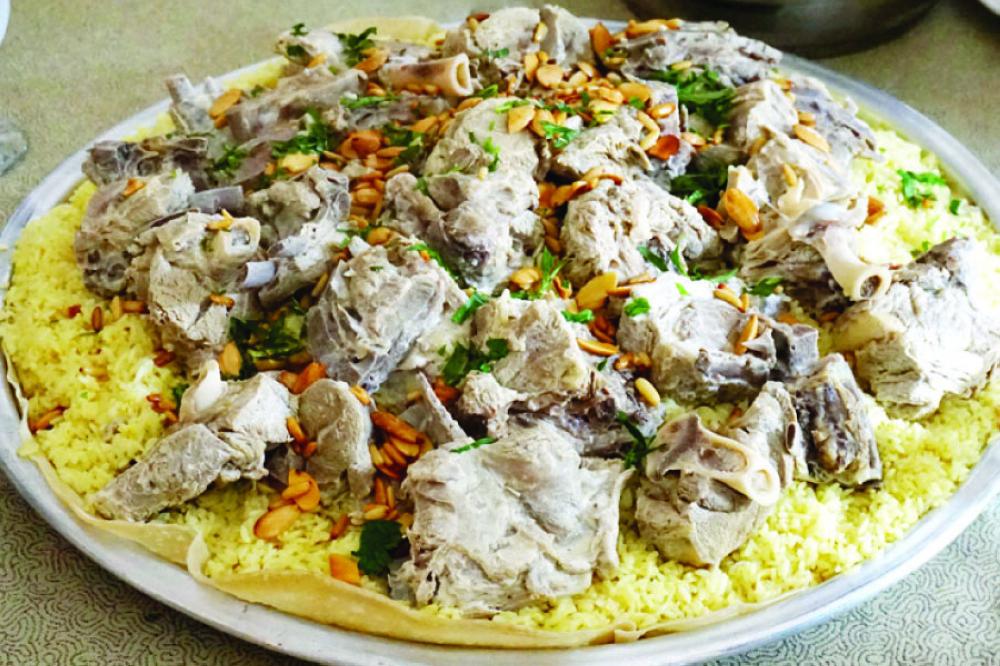 (المنسف): The undisputed national dish of Jordan, prepared using rice and pieces of lamb or goat meat cooked in Jameed (dried fermented yogurt). It is served at large gatherings and banquets.
(المنسف): The undisputed national dish of Jordan, prepared using rice and pieces of lamb or goat meat cooked in Jameed (dried fermented yogurt). It is served at large gatherings and banquets. - MakmouraMakmoura
 : is a renowned, traditional dish highly specific to the cuisine of Northern Jordan (Irbid and Ajloun Governorates). It is essentially a thick, layered pie baked for several hours. It consists of layers of rich dough enclosing copious amounts of onions, chicken pieces, and high-quality olive oil. It is considered a festive and warming winter feast dish.
: is a renowned, traditional dish highly specific to the cuisine of Northern Jordan (Irbid and Ajloun Governorates). It is essentially a thick, layered pie baked for several hours. It consists of layers of rich dough enclosing copious amounts of onions, chicken pieces, and high-quality olive oil. It is considered a festive and warming winter feast dish. - Kibbeh or kebab: It is one of the dishes that is prepared in all regions, as its spread extended from the villages north of Irbid, such as the villages of Bani Kenana.
-
Al-Matabiq (Stuffed Bread): Local bread baked on a *Saj* (metal dome) or in a *Taboun* (clay oven), stuffed before baking with various fillings such as onions and sumac, fresh wild thyme, or minced meat.
-
Maqluba/MaglubaMaqluba
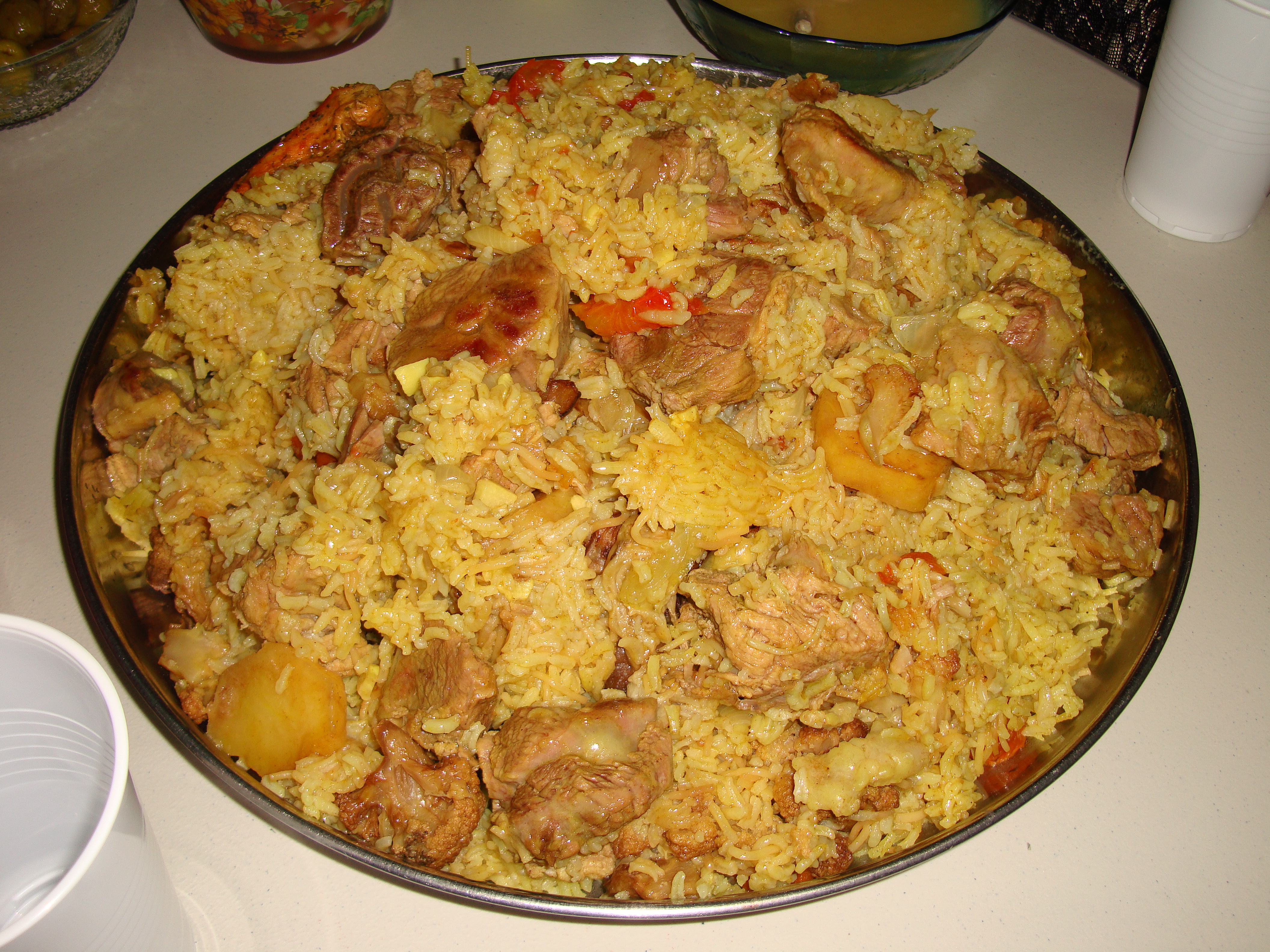 (المقلوبة): A casserole dish made by layering rice, vegetables, and meat. After cooking, the pot is flipped upside-down onto the serving platter, hence the name Maqluba, which literally translates to "Upside-down."
(المقلوبة): A casserole dish made by layering rice, vegetables, and meat. After cooking, the pot is flipped upside-down onto the serving platter, hence the name Maqluba, which literally translates to "Upside-down." -
Musakhan:Musakhan
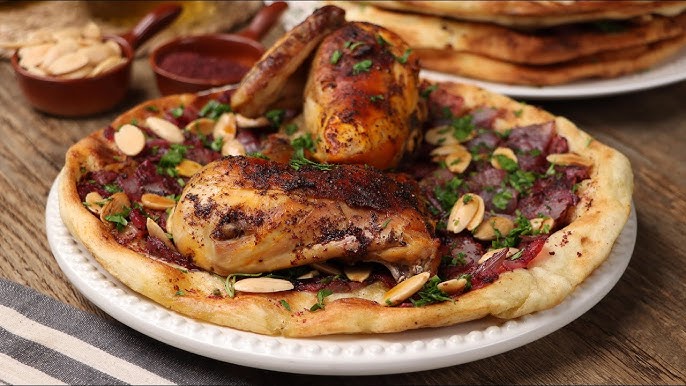 (المسخن): A famous Palestinian and Jordanian dish composed of baked roasted chicken seasoned with onions, sumac, spices, saffron, and fried pine nuts. It is served atop Taboon bread. It is also commonly known as Al-Muhannar.
(المسخن): A famous Palestinian and Jordanian dish composed of baked roasted chicken seasoned with onions, sumac, spices, saffron, and fried pine nuts. It is served atop Taboon bread. It is also commonly known as Al-Muhannar. -
Maftoul:Maftul
 (المفتول): Large, pearl-like grains similar to couscous, which are cooked along with chickpeas and pieces of chicken in a rich, savory chicken broth.
(المفتول): Large, pearl-like grains similar to couscous, which are cooked along with chickpeas and pieces of chicken in a rich, savory chicken broth. - Al-Dafeen (Freekeh - الدفين): A staple meal centered around Freekeh (roasted green wheat grains). It is named Al-Dafeen (meaning "the buried") in some regions when it is prepared by burying it underground or cooking it over coals, which imparts a distinctive smoky and rich flavor.
- Al-Ja'ajeelAl-Ja'ajeel (Kaakil or Shaashil)
 (Kaakil or Shaashil) (الجعاجيل):: This is a unique traditional dish specific to Northern Jordan (Irbid region), although shared popular dishes exist across all Jordanian governorates.
(Kaakil or Shaashil) (الجعاجيل):: This is a unique traditional dish specific to Northern Jordan (Irbid region), although shared popular dishes exist across all Jordanian governorates. - Ādhān al-ShāyibĀdhān al-Shāyib (آذان الشايب)
 (آذان الشايب): (meaning "Old Man’s Ears"), also known as Shishbarak or Shushbarak (and occasionally as "Ādhān Qiṭāṭ" in parts of Southern Jordan), is a renowned dish across the Levant, particularly in Jordan (specifically Northern Jordan), Syria, Northern Saudi Arabia, the Hejaz, Central Asia, the Southern Caucasus, and the wider Middle East. Its origins are traced back to Uzbekistan (where similar dishes are known as Jushpara or Manti). The dish consists of small dough parcels filled with seasoned minced lamb and meticulously folded to resemble a human ear.
(آذان الشايب): (meaning "Old Man’s Ears"), also known as Shishbarak or Shushbarak (and occasionally as "Ādhān Qiṭāṭ" in parts of Southern Jordan), is a renowned dish across the Levant, particularly in Jordan (specifically Northern Jordan), Syria, Northern Saudi Arabia, the Hejaz, Central Asia, the Southern Caucasus, and the wider Middle East. Its origins are traced back to Uzbekistan (where similar dishes are known as Jushpara or Manti). The dish consists of small dough parcels filled with seasoned minced lamb and meticulously folded to resemble a human ear.
Starters and Common Traditional Meals
- Galayet BandoraGalayet Bandora
 (قلاية البندورة - Fried Tomato Dish): A quintessential Jordanian and Levantine staple. This dish consists of diced tomatoes fried and simmered with onions, olive oil, salt, and chili pepper. While it can be served with rice, it is most commonly enjoyed in Jordan by dipping fresh bread into it. It is an indispensable meal for all segments of society across the governorates.
(قلاية البندورة - Fried Tomato Dish): A quintessential Jordanian and Levantine staple. This dish consists of diced tomatoes fried and simmered with onions, olive oil, salt, and chili pepper. While it can be served with rice, it is most commonly enjoyed in Jordan by dipping fresh bread into it. It is an indispensable meal for all segments of society across the governorates. - FalafelFalafel
 (الفلافل): Deep-fried balls or patties made from ground chickpeas (or fava beans) mixed with Middle Eastern spices. Falafel is a central part of any mezze platter and is especially common when dipping into Hummus. Jordanian Falafel patties tend to be smaller in size compared to other regional variations.
(الفلافل): Deep-fried balls or patties made from ground chickpeas (or fava beans) mixed with Middle Eastern spices. Falafel is a central part of any mezze platter and is especially common when dipping into Hummus. Jordanian Falafel patties tend to be smaller in size compared to other regional variations. - Hummus and Fuul MedamesHummus and Fuul Medames
 (الحمص والفول - Chickpea Dip and Fava Beans): These two dips are traditionally served together for breakfast, particularly on Fridays. They are also common as appetizers (mezze) during lunch and dinner.
(الحمص والفول - Chickpea Dip and Fava Beans): These two dips are traditionally served together for breakfast, particularly on Fridays. They are also common as appetizers (mezze) during lunch and dinner.
- Hummus: A creamy dip made from mashed chickpeas, tahini (sesame paste), lemon juice, and garlic.
- Ful Medames: Stewed fava beans seasoned with lemon juice, garlic, and cumin.
Desserts
-
Al-Lazaqiyyat: A rural dessert baked on the *Saj* in thin layers (similar to *Qatayef* batter), generously drizzled with *Samn Baladi* and sugar or honey.
-
Baklava:Baklava
 A rich and delicious pastry made of thin, crispy layers of phyllo doughPhyllo Pastry
A rich and delicious pastry made of thin, crispy layers of phyllo doughPhyllo Pastry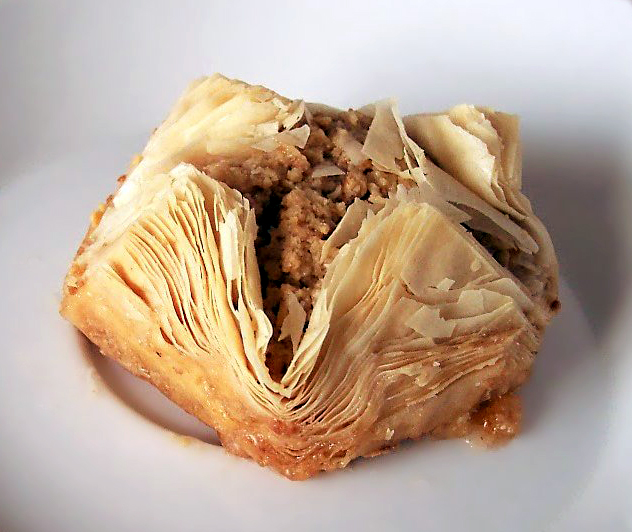 , stuffed with chopped nuts (often pistachios or walnuts), and generously soaked in honey or Qater (simple sugar syrup).
, stuffed with chopped nuts (often pistachios or walnuts), and generously soaked in honey or Qater (simple sugar syrup). -
Knafeh:Knafeh
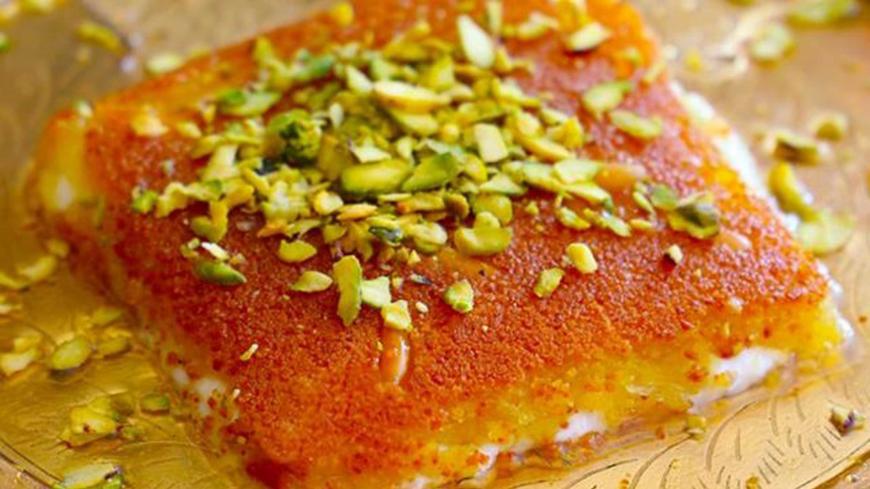 A famous and distinctive Middle Eastern dessert based on cheese. It consists of coarse Knafeh dough or fine semolina threads, layered over soft cheese, and then soaked in a sugar syrup often flavored with rose water.
A famous and distinctive Middle Eastern dessert based on cheese. It consists of coarse Knafeh dough or fine semolina threads, layered over soft cheese, and then soaked in a sugar syrup often flavored with rose water. -
Warbat:Warbat
 Thin, triangular pastries made from layers of crispy phyllo dough and stuffed with sweet, smooth cream (or custard). Like Qatayef, Warbat is consumed extensively during the Holy Month of Ramadan.
Thin, triangular pastries made from layers of crispy phyllo dough and stuffed with sweet, smooth cream (or custard). Like Qatayef, Warbat is consumed extensively during the Holy Month of Ramadan. -
Qatayef:Qatayef
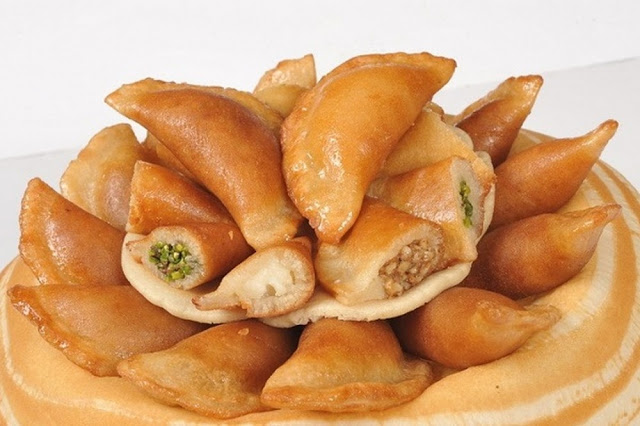 A unique stuffed pancake-like dessert specific to the region. It resembles a folded pancake and is traditionally filled with fresh cream (Qeshta) or ground pistachios. It is a famous dessert consumed mainly during the Holy Month of Ramadan.
A unique stuffed pancake-like dessert specific to the region. It resembles a folded pancake and is traditionally filled with fresh cream (Qeshta) or ground pistachios. It is a famous dessert consumed mainly during the Holy Month of Ramadan.
Area and Population of Irbid Governorate
Irbid Governorate is considered one of Jordan's most vital provinces. It ranks as the second-largest governorate in Jordan by population and holds the distinction of having the highest population density in the country.
- Approximate Population: About 2,095,700 inhabitants.
- Governorate Area: Approximately 1,572 square kilometers (1,572 km²), which is equivalent to about (607 square miles).
- Population Density: The highest in Jordan.
Related Topics: Mafraq | Jerash | Ajloun | Amman
All Rights Reserved | gpsarab.com - © 2012-2025
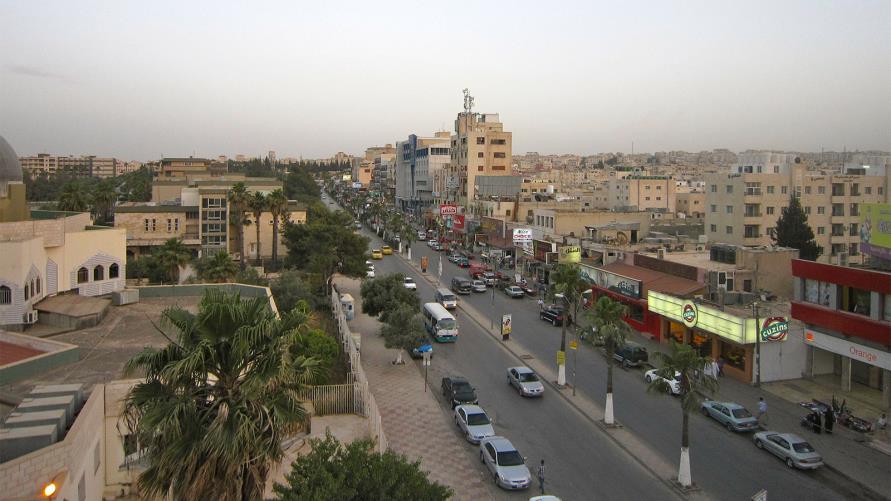

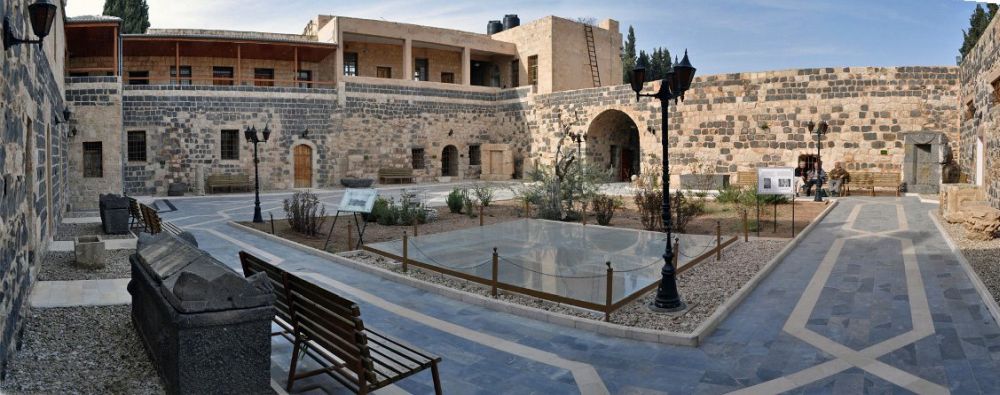

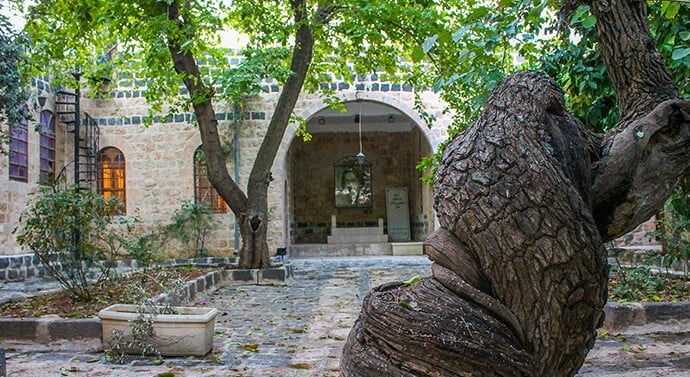

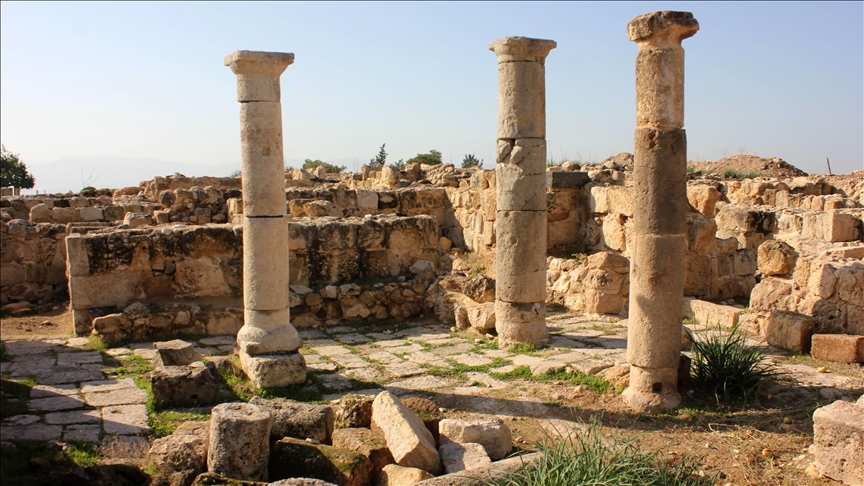
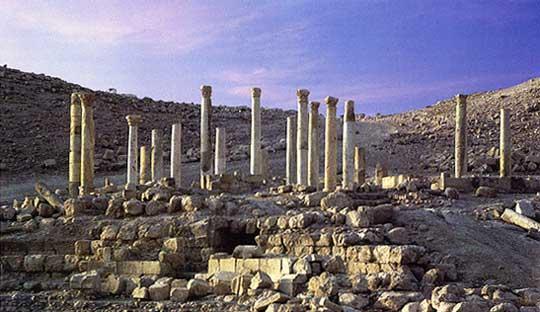
Be the first to comment on this topic!
Leave a Comment